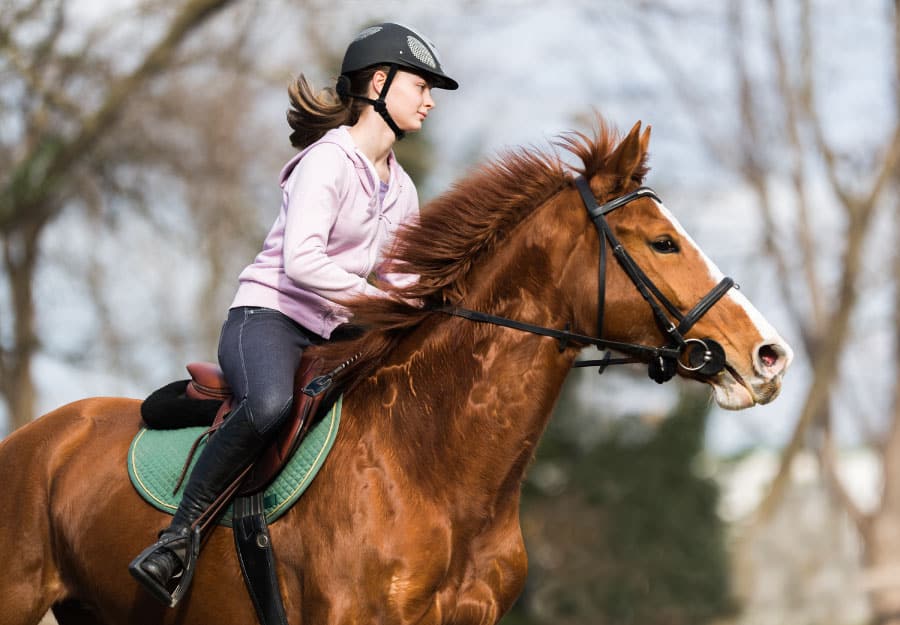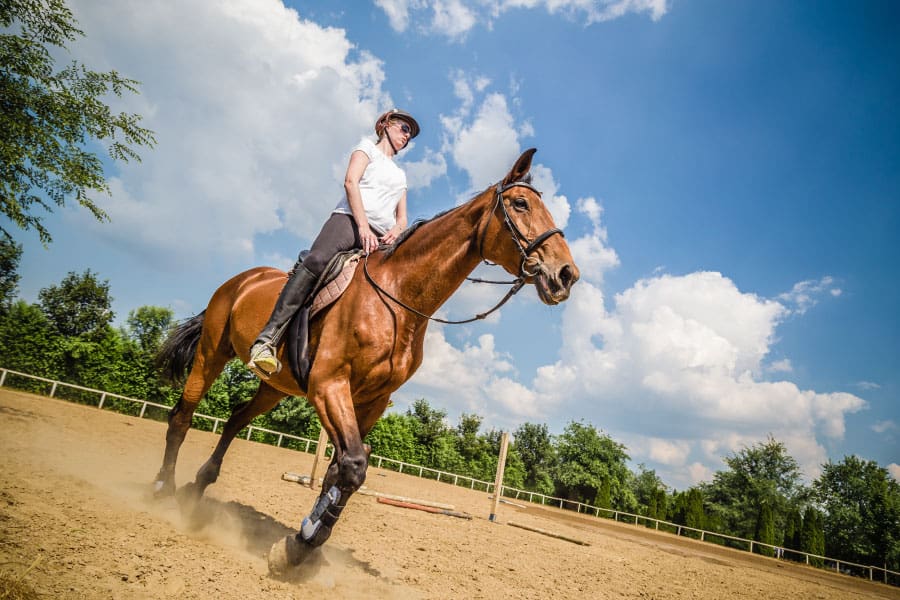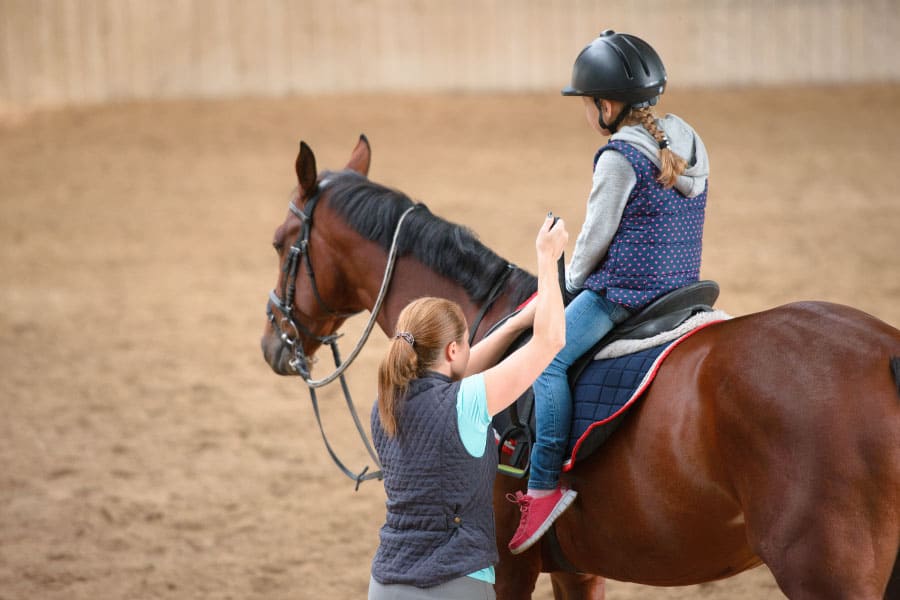- Your source for stall mats, rubber arena footing, arena harrows and arena dust control.

Are you a horse enthusiast wanting to start riding? Have you purchased your first horse and now want to start riding? In this article, we’ll look ar ways how you can teach yourself how to ride as well as give some tips on riding.
Yes, It is possible to teach yourself how to ride a horse and there are many resources available for learning all the basics needed to get started. However, you would need the right equipment, the right horse and eventually you will also need an instructor to take you further and teach you proper equitation.
Let’s look further into it. There are many benefits to learning how to ride a horse, so I will give you some tips on where to get started.
When did horse riding start?
Horse riding started years and years ago. No one is entirely sure when exactly it started and when horses where domesticated but horses and humans had a relationship from as far as 6000 years ago. The first proper harnesses were made in China around 200 BC.
Xenophon , a Greek historian, was a remarkable horseman and a big lover of horses and horse riding.
, a Greek historian, was a remarkable horseman and a big lover of horses and horse riding.
“If one induces the horse to assume that carriage which it would adopt of its own accord when displaying its beauty, then, one directs the horse to appear joyous and magnificent, proud and remarkable for having been ridden.”
Xenophon
Xenophon learned how to ride horses when he was in the Cavalry. He wrote a book, amongst many others, that is still applicable in today’s modern riding – “On Horsemanship .” He wrote his book 1900 years before the infamous Spanish Riding School opened. He’s received the well-deserved name of The Forefather of Dressage.
.” He wrote his book 1900 years before the infamous Spanish Riding School opened. He’s received the well-deserved name of The Forefather of Dressage.
He wrote about training men and horses for war but also on Equitation and riding of show horses. He noted that a rider must keep a quiet seat, especially in the case of riding a more spirited horse. Some of his teachings were later used in the Spanish Riding school as well.
The Spanish Riding School
Located in Vienna, the Spanish riding school has been standing for around 448 years (the exact date is unclear). This school is the only riding school that still uses the Classical art of riding that started in the Renaissance era.
has been standing for around 448 years (the exact date is unclear). This school is the only riding school that still uses the Classical art of riding that started in the Renaissance era.
This school was not only used to train the Spanish horses; it was also used for jousting tournaments, carousels, and balls. It was also later used for meetings between the Citizens of Vienna and the Reichstag around 1848.
Today, the white Lippizaner stallions still train every morning and perform once a week.
Benefits of horse riding
Here are some of the many, many benefits of horse riding:
- Horse riding improves balance, motor coordination, hand-eye coordination, and muscular development. This also teaches body-awareness
- It improves cognitive abilities – this can affect their learning, memory, and problem-solving skills
- Riding improves the sympathetic nervous system in children
- Riding can also improve rhythm, concentration, and emotional development
- Riding develops self-confidence
- Horse riding provides for good physical exercise as well as cognitive exercise, the cardiovascular system is improved, and it acts as a stress reliever
- Riding has therapeutical and psychological benefits
- Horses are sensitive to emotion, and riding will develop emotional awareness and control
- Shyness or Timidness are reduced by horse riding as people tend to open up more towards horses
- For younger children, horse riding can be very educational
- Riding teaches responsibility
- Improved muscle tone and flexibility
What equipment is needed for horse riding?
Before jumping onto your horse, you will need to have the right equipment not only for yourself but also for your horse.
For you:
- A Riding helmet
- Long pants or Jodphurs
- Closed shoes with a heel or riding boots
- Gaiters or Chaps
- Gloves
For your horse:
- A proper fitting bridle and bit
- A proper fitting saddle, completed with a good quality girth, stirrups and stirrup leathers
- A neck strap or Martingale can help you for balancing
- Brushing or Tendon boots
- A good quality numnah
Knowing the tack and how to use it is of utmost importance. Learn how to properly tack up your horse.

Having the right horse/rider combination
Ever heard the saying “Green on Green makes Black and Blue”? This means that a beginner rider should not ride on an inexperienced and young horse. This can be very dangerous for both rider and horse.
A good temperament in a horse is quite easy to find. Find a horse that is calm, relaxed, and willing. Your horse should be confident and easy-going, as this will resonate with you when you first start out. “School Master” horses are the best horses that are suitable for beginner riders.
Having good horse etiquette is especially important, as horses are, by nature, prey animals. This means that they spook easily.
Here are some tips for getting started:
- Avoid sudden fast movements around the horse
- Approach the horse towards their shoulder, touch their shoulder and run your hand from there to where you would like to go
- Avoid going behind the horse unless necessary and while knowing the horse
- Avoid loud noises
- Do not approach a horse when angry or anxious; horses are very sensitive to body language and emotions
- When mounting a horse, use a mounting block or have someone assist by giving you a ‘leg-up.’
- Learning how to care for your horse is also an essential aspect of horse riding; this includes:
- Grooming
- General care
- Leading and working with the horse on the ground
Teaching yourself how to ride a horse
As previously mentioned, there are many great resources to use when teaching yourself how to ride. But it is better to have a knowledgeable horseperson around to help you out. Horse riding, while fun, can be dangerous as you are riding a large animal with their own mind and own personality.
Some resources you can use to get started:
- YouTube – there are many how-to videos on YouTube to learn the basics on how to ride a horse.
- Listening in on lessons – sitting in on lessons at a stable yard is very beneficial for you and your horse as one can listen to the instructions and watch, while you and your horse follow along.
- Books/e-books and the internet – Google can be your best friend. There are many helpful books and e-books, as well as websites that can teach you to learn more about riding and equestrianism.
Posture
It is vital to have the correct posture when riding a horse as this will help you find your balance and not disrupt the balance of the horse.
When learning the basics, using an English style Dressage saddle is your best bet as transitioning from that saddle to other saddles is relatively easy. A dressage saddle also helps you find the correct balance, seat position, and leg position.
Muscle-memory
Riding a horse takes a lot of practice. In this way, you will build up the strength and muscle memory to ride. This also means that you need to ride at least 3 times a week to build up the strength to ride better.
You can only improve with the right amount of practice. There are also many helpful exercises that you can do at home to prepare yourself for riding as well as strengthening your body.
Some exercises you can do to improve your riding:
- Plank, sit-ups, crunches, and leg raises – for strengthening your core
- Squats, lunges, and exercise balls – for strengthening your legs
- Pull-ups, push-ups, and dumbbell exercises – for strengthening your upper body
- Superman lifts, dumbbell rows, bent over rows – for strengthening your back
How long does it take to learn to ride a horse?
Professional horsemanship is a lifelong experience. Learning the basics, depending on your dedication, strength, and balance, can easily be learned in the first few months.
But truly riding a horse and proper equestrianism can take many years as mastering horse riding takes a lot of riding, falling, sweat, dedication, horses, failures, and lessons to achieve.

Problems with teaching yourself
It is always better to have a knowledgeable and experienced person with you when you learn how to ride a horse. They can teach you the basics, proper care, and proper riding techniques.
Teaching yourself how to ride can take longer, and may lead to some problems in the future.
Here are some disadvantages to teaching yourself how to ride a horse:
- Dangerous – if you are inexperienced with horses, the risk of injuring yourself, someone else, or the horse increases.
- Bad habits – without having someone on the ground helping you, you can develop bad riding habits that will increasingly become harder to stop the longer you ride.
- Time – it will require much longer to learn the basics of horse riding without someone assisting you, especially in the trot and canter.
- Balance and strength – when riding by yourself, you may develop some techniques that use the wrong muscle groups. This will also take a long time to correct.
- Your horse – when using the incorrect aids on your horse, it will cause your horse to become confused. This will lead to wrong movements and less confidence in the horse. Your horse also needs to work correctly to avoid injury in the long run. When teaching yourself how to ride, you cannot focus on what to ask the horse, and this can lead to many problems with your horse.
- Experience – it takes years of experience on how to read signals from your horse. A horse cannot speak; thus, they act out their emotions, and this can become very dangerous. An experienced person will be able to tell you what might be causing these actions from your horse and what you can do to help.
Benefits of having an instructor
Here are some benefits of having a riding instructor:
- Time – they can cut the time of teaching yourself how to ride and teach you the basics of riding more effectively.
- Experience – Instructors know more about caring and riding horses and are qualified to teach you what you need to know when you need to know it.
- Riding – a good instructor can teach you how to ride properly and effectively with the right techniques for the chosen discipline.
- Problems with your horse – a good instructor can point out causes for problems in your horse, such as ill-fitting tack, riding habits, and lameness or injury.
- Horse riding instructors are passionate and love what they do. They will always be willing to help or give you helpful tips.
- Physical and Mental blocks – a good riding instructor can help you with your riding, especially therapeutic riding. A therapy riding instructor is very important in the case of the rider having any disabilities or challenges, as horse riding can often help.
- Proper training for your horse – your instructor can help you to help your horse perform better by giving you certain exercises to improve your horse’s balance and strength.
- Instructors help you find the best possible discipline for you and your horse as well as proper training in that specific discipline.
- Matching you with a horse that will suit your riding needs.
Conclusion
As you may have noticed from the article, although it is entirely possible to teach yourself how to ride a horse, I would strongly encourage you to learn the basics from a qualified instructor instead.
That being said and whether you choose to teach yourself or learn with an instructor, as long as you enjoy it and have fun because there’s nothing quite like riding and sharing that amazing connection with a horse.

